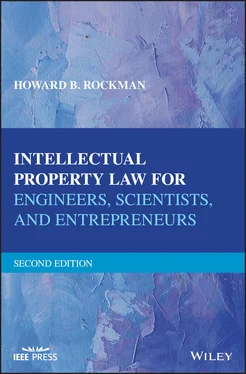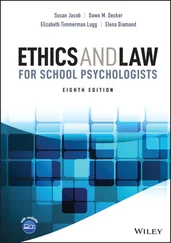8.3 ADDITIONAL TYPES OF SEARCHES
In addition to the patentability search, there are other searches for existing patents and published technology that can be conducted. Keep in mind that the patentability search discussed above is directed to answering the question “Is the invention sufficiently novel and non‐obvious to be patentable?” Or to put it in a more practical way, “Should the inventor proceed to spend his or her resources to obtain a patent?”
8.3.1 The Freedom‐to‐Use Search
Since others normally have obtained patents in the field related to your invention, a freedom‐to‐use search should be conducted upon completion of the development of the product or process embodying your invention, which asks the question “Will my new invention, as embodied in a marketable product or process, infringe another unexpired patent of which we are currently unaware?” By way of a hypothetical example, suppose your new invention relates to a pencil having an eraser on one end. It would be important to find out whether anyone holds a patent on a pencil alone, because the manufacture and sale of your pencil plus eraser will infringe the earlier patent owner’s right to exclusively make, use or sell pencils. Thus, the purpose of a freedom‐to‐use search is to uncover prior active unexpired patents to determine whether your invention, or any subset of your invention, would be covered by claims of another unexpired patent.
In conducting a freedom‐to‐use search, each claim of the unexpired patents uncovered by the search must be examined to determine whether your invention may be covered by any of these claims. If only a single claim in a patent reads on your product or process, that patent is infringed. If it is found that there is a possibility of an infringement issue arising upon the marketing of your new product or process, a right‐to‐use search may be appropriate (see Section 8.3.3). Alternatively, it may be possible to create a modification of your invention or device which “designs around” the patent claims that potentially cause infringement problems. In so doing, you are attempting to avoid infringement.
8.3.2 State‐of‐the‐Art Search
Another type of search that can be conducted is the state‐of‐the‐art search, which asks the question “What is the general state of the art or technology concerning the area of my invention?” The results of this search are broader in scope than a patentability search, but the search is still limited to the technology related to your invention. This type of search normally results in a collection of patents, published patent applications, and literature that yield valuable technical data and knowledge concerning the area of related technology, and may be useful to an inventor in further development of the invention, so long as potential infringement problems are avoided.
8.3.3 Right‐to‐Use Search
A further type of search, alluded to above, is the right‐to‐use search. This is also commonly called a validity search. This search attempts to answer the question “Even if it appears that the invention or device under analysis infringes another unexpired issued patent, is there a basis for determining that the potentially infringed patent is invalid or otherwise cannot or should not be enforced with respect to my invention?” Prior to initiating this type of search, the patent attorney normally analyzes how the potentially infringed issued patent was obtained by reviewing the prosecution history or “file wrapper” of the subject patent before the U.S. Patent & Trademark Office. This analysis includes an evaluation of the prior art applied by the Patent Examiner against the claims of the potentially infringed patent. Very often, in obtaining a patent and avoiding the prior art, the patent attorney, during prosecution of that patent and amending the claims, will represent to the Patent Examiner that the language and scope of the patent claims are somehow limited to specific structure or process steps not shown in the applied prior art. Such admissions by the patentee’s attorney in the prosecution history can be used to show that an accused device falls outside a particular claim limitation. The prosecution history analysis attempts to find these limitations, or loopholes, in the scope of protection of the potentially infringed patent. From the relevant communications and changes to the claims made by the attorney to the Patent Examiner in the prosecution of the potentially infringed patent, your attorney can determine whether or not your invention falls inside or outside the issued patent’s scope of protection.
Following such an analysis, if it is determined that your invention may still potentially infringe one or more claims of the issued patent in question, a right‐to‐use search is requested from a searcher in an effort to obtain prior art not considered previously by the Patent Examiner which would render the claims in question anticipated or obvious, and therefore invalid.
The searches conducted up to a few years ago were conducted by the searcher manually leafing through the collections of paper patents in the public search facilities of the U.S. Patent & Trademark Office. However, most, if not all, search associates today use a computer database in conducting their searches.
The website of the U.S. Patent & Trademark Office ( www.uspto.gov) provides one with the ability to search all patents issued in the United States since the year 1976 using key word search techniques. Patents issued between 1790 and 1975 are available in image format only if you know the patent number. Thus, today both manual and computer database searching are combined to conduct a complete search of issued patents and published patent applications. Assuming that the inventor and patent attorney have provided the searcher with the identity of the inventor’s largest competitors in the area of technology covered by the search, the searcher can also use the U.S. Patent & Trademark Office database to obtain a list of all patents and the titles of these patents owned by each competitor subsequent to 1976. This will enable the searcher to pinpoint particular patents, and furnish the patent attorney and the inventor with a precise list of relevant patents owned by such competitors. The same key word techniques are used to conduct an Internet literature search.
The U.S. Patent & Trademark Office database allows searching by subject matter back to 1976, through the incorporation of key words into the search. Thus, if you are looking at a combination of electrical heating elements particularly useful for heating engine blocks, by typing the key words “heater” and “engine block” into the computer search engine, you will obtain the numbers of referenced patents issued since 1976 that correspond to that key word search. The same applies to searching published patent applications. Thus, it is important to provide your patent attorney with as much information as possible regarding the terms used in defining the technology to be searched so that these terms may be keyed into the database search.
8.5 U.S. PATENT AND TRADEMARK OFFICE PATENT CLASSIFICATION SYSTEM
Because of the vast number of patents that are filed and cross‐referenced in its database, the U.S. Patent & Trademark Office employs a numerical classification system to identify each of the many areas of technology. Class and subclass numerical designators pinpoint the specific technology and art to be searched. By examining the first page of a patent, the numbers of the classification system appear as “Field of Search.” All of these classifications are listed in a rather extensive classification manual. The entire manual is posted on the U.S. Patent & Trademark Office website ( www.uspto.gov).
Читать дальше












